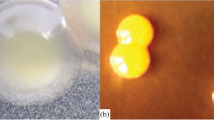Abstract
One hundred fifty wild strains ofXanthomonas were isolated on five selective and nonselective media. The comparative effectivity of the five media has been discussed. Fifteen polysaccharide-producing strains shortlisted were identified up to species level. These were studied for polysaccharide production in shake flasks using YM media. The highest final yield of 21.3 g/L of the amount of carbon source supplied has been obtained in the optimum medium in shake-flask experiments fromXanthomonas campestris ICa-125 strain isolated from cabbage. Rheological properties of the exocellular polysaccharide (EPS) have been compared with standard xanthan. EPS fromX. campestris ICa-125 was found to be superior with respect to heat stability and effect of electrolytes as compared to standard xanthan.
Similar content being viewed by others
References
Albrecht W.J., Sohns U.E., Rogovin S.P.: Pilot-plant process for the isolation of a microbial polysaccharide with a quaternary ammonium compound.Biotechnol. Bioeng.5, 91–99 (1963).
Breed R.S.:Bergey's Manual of Determinative Bacteriology, 7th ed. (R.S. Breed, E.G.D. Murray, N.R. Smith, Eds), pp. 152–178. Williams & Wilkins, Baltimore 1957.
Cadmus M.C., Rogovin S.P., Burton K.A., Pittsley J.E., Knutson C.A., Jeanes A.: Colonial variation inXanthomonas campestris NRRL B-1459 and characterization of the polysaccharide from a variant strain.Can. J. Microbiol.22, 942–948 (1976).
Cadmus M.C., Knutson C.A., Lagoda A.A., Pittsley J.E., Burton K.A.: Synthetic media for production of quality xanthan gum in 20 liter fermentors.Biotechnol. Bioeng.20, 1003–1014 (1978).
Chin-Hang Shu, Shang-Tian Yang: Kinetics and modelling of temperature effect on batch xanthan gum fermentation.Biotechnol. Bioeng.37, 567–574 (1991).
Fernando F., Torres L.G., Galindo E.: Effect of dissolved oxygen tension during cultivation ofX. campestris on the production and quality of xanthan gum.J. Biotechnol.34, 165–173 (1994).
Garcia-Ochoa F., Casas J.A., Mohedano A.F.: Xanthan precipitation from solutions and fermentation broths.Separat. Sci. Technol.28, 1303–1313 (1993).
Harper H.A.:Carbohydrates: Review of Physiological Chemistry, 14th ed. Large Medical Publication, Maruzen Asian Co., Los Altos (California) 1973.
Hassler R.A., Doherty D.H.: Genetic engineering of polysaccharide structure: production of variants of xanthan gum inXanthomonas campestris.Biotechnol. Progr.6, 182–187 (1990).
Jeanes A., Rogovin P., Cadmus M.C., Silman R.W., Knutson C.A.:Polysaccharide (Xanthan) of Xanthomonas campestrisNRRL B-1459: Procedures for Culture Maintenance and Polysaccharide Production, Purification and Analysis, ARS-NC 51, Agricultural Research Service, USDA, Peoria (USA) 1976.
Kado C.I., Heskett M.G.: Selective media for isolation ofAgrobacterium, Corynebacterium, Erwinia, Pseudomonas & Xanthomonas.Phytopathology60, 969–976 (1970).
Kennedy J.F., Jones P., Barker S.A.: Factors affecting microbial growth and polysaccharide production during the fermentation ofXanthomonas campestris culture.Enzyme Microbiol. Biotechnol.4, 39–43 (1982).
Kennedy J.F., Bradshaw I.J.: Production properties and applications of xanthan.Progr. Industr. Microbiol.19, 319–371 (1984).
Koníček J., Lasík J., Wurst M.: Production and characteristics of the exocellular polysaccharide in mutant strains ofXanthomonas fuscans.Folia Microbiol.22, 12–18 (1977).
Luc De Vuyst, Jan Van Loo, Vandamme E.J.: Two step fermentation process for improved xanthan production byXanthomonas campestris NRRL B-1459.J. Chem. Technol. Biotechnol.39, 263–273 (1987).
Luc De Vuyst, Vermeire A.: Use of industrial medium components for xanthan production byXanthomonas campestris NRRL B-1459.Appl. Microbiol. Biotechnol.42, 187–191 (1994).
Martinez-Salazar J.M., Palacios A.M., Sanchez R., Caro A.D., Soberon-Chavez G.: Genetic stability and xanthan gum production inXanthomonas campestris pv.campestris NRRL B-1459.Mol. Microbiol.8, 1053–1061 (1993).
Millane R.P., Narasaiah T.V.: X-ray fiber diffraction studies of a variant of xanthan gum in which the sidechain terminal mannose unit is absent.Carbohydr. Polym.12, 315–321 (1990).
Moraine R.A., Rogovin P.: Xanthan biopolymer production at increased concentration by pH control.Biotechnol. Bioeng.13, 381–391 (1971).
Moraine R.A., Rogovin P.: Kinetics of xanthan fermentation.Biotechnol. Bioeng.15, 225–237 (1973).
Nitschke M., Thomas R.W.S.P.: Xanthan gum production by wild-type isolates ofXanthomonas campestris.World J. Microbiol. Biotechnol.11, 502–504 (1995).
Ramirez M.E., Fucikovsky L., Garcia-Jimenez F., Quintero R., Galindo E.: Xanthan production by altered pathogenicity variants ofXanthomonas campestris.Appl. Microbiol. Biotechnol.29, 5–10 (1988).
Roseiro J.C., Costa D.C., Collaco M.T.A.: Batch and fed-batch cultivation ofXanthomonas campestris in carob extracts.Lebensm. Wiss. Technol.25, 289–293 (1992).
Roseiro J.C., Girio F.M., Kara A., Collaco M.T.A.: Kinetic and metabolic effects of nitrogen, magnesium and sulphur restriction inXanthomonas campestris batch cultures.J. Appl. Bacteriol.75, 381–386 (1993).
Schaad N.W., White W.C.: A selective medium for soil isolation and enumeration ofXanthomonas campestris.Phytopathology64, 876–880 (1974).
Sharma A., Nair P.M., Pawar S.E.: Identification of soybean strains resistant toXanthomonas campestris pv.glycines.Euphytica67, 95–99 (1993).
Starr M.P.: The genusXanthomonas, pp. 742–763 inThe Procaryotes, Vol. 1, 2nd ed. (M.P. Starr, H. Stolp, H.G. Truper, A. Balows, H.G. Schlegel, Eds). Springer Verlag, Berlin-Heidelberg 1986.
Tait M.I., Sutherland I.W., Clarke-Sturman A.J.: Effect of growth conditions on the production, composition and viscosity ofXanthomonas campestris exopolysaccharide.J. Gen. Microbiol.132, 1483–1492 (1986).
Trilsbach J.F., Pielken P., Hamacher K., Sahm H.: Xanthan formation byXanthomonas campestris under different culture conditions, pp. 65–70 inThird European Congress on Biotechnology, Vol. II. Verlag Chemie, Berlin 1984.
Vermani M.V., Kelkar S.M., Kamat M.Y.: Novel polysaccharide produced byAzotobacter vinelandii isolated from plant rhizosphere.Biotechnol. Lett.17, 917–920 (1995).
Author information
Authors and Affiliations
Rights and permissions
About this article
Cite this article
Gupte, M.D., Kamat, M.Y. Isolation of wildXanthomonas strains from agricultural produce, their characterization and potential related to polysaccharide production. Folia Microbiol 42, 621–628 (1997). https://doi.org/10.1007/BF02815476
Received:
Revised:
Issue Date:
DOI: https://doi.org/10.1007/BF02815476




